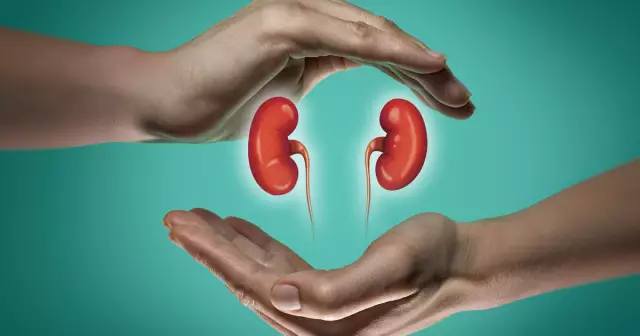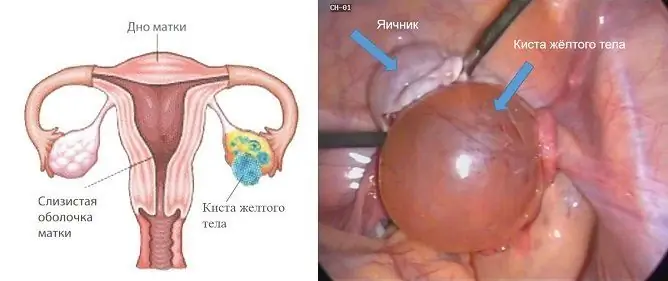- Author Rachel Wainwright [email protected].
- Public 2023-12-15 07:39.
- Last modified 2025-11-02 20:14.
Ovarian dysfunction
The content of the article:
- Causes and risk factors
- Forms of the disease
- Signs of ovarian dysfunction
- Diagnostics
- Ovarian dysfunction treatment
- Possible complications and consequences
- Forecast
- Prevention
Ovarian dysfunction (from Lat. Dis - denial, difficulty + functio - action, implementation), or ovarian dysfunction - dysfunction of the ovaries caused by endocrine pathologies or inflammatory processes. Ovarian dysfunction entails the development of a number of pathological conditions, the most characteristic of which are menstrual disorders and anovulatory disorders leading to infertility.

Source: aginekolog.ru
At the heart of any form of ovarian dysfunction is always a violation of the synthesis and secretion of three main hormones produced by the pituitary gland: follicle-stimulating hormone (FSH), luteinizing hormone (LH), prolactin (PRL). A prerequisite for the maturation of follicles, ovulation and the onset of pregnancy is a special ratio of the content of these hormones in each phase of the menstrual cycle. With hormonal disorders, this ratio changes, the menstrual cycle is not observed and all successive phases do not go through, menstrual bleeding becomes acyclic.
Women can take minor cycle disorders as a feature of their body. However, any deviation from the normal menstrual cycle can be a sign of ovarian dysfunction.
Parameters of a normal menstrual cycle:
- the duration is not less than three and not more than seven days;
- the interval between menstruation is 21-35 days;
- blood loss during menstruation 50-100 ml.
Causes and risk factors
The most common causes of ovarian dysfunction are:
- endocrine diseases, pathologies of the thyroid gland, pituitary gland or adrenal glands;
- inflammatory diseases of the organs of the reproductive system (ovaries, uterus, appendages);
- artificial termination of pregnancy (a special danger is the artificial termination of the first pregnancy);
- endometriosis;
- tumors of the reproductive system;
- pathology of the fallopian tubes;
- incorrect position of the intrauterine device in the uterine cavity;
- metabolic disorders - diabetes mellitus, obesity;
- taking medications that affect the reproductive system;
- prolonged fasting, lack of vitamins C and E.

Source: medware.ru
The following categories of women are at risk:
- having a burdened heredity;
- suffering from chronic inflammatory diseases;
- have no history of pregnancy;
- have undergone increased psychoemotional stress.
Since the formation of ovarian dysfunctions begins in girls even in puberty, it is necessary to pay attention in a timely manner to the onset of menstruation, menstrual irregularities, the development of manifestations of hyperandrogenism and obesity.
Forms of the disease
Ovarian dysfunction can take different clinical forms and manifest itself in the form of specific neuroendocrine syndromes:
- polycystic ovary syndrome;
- ovarian hyperfunction;
- metabolic syndrome (obesity, high blood sugar, high blood pressure);
- primary ovarian failure (low estrogen, fraught with premature menopause);
- Itsenko-Cushing's syndrome;
- hypothyroidism and hyperthyroidism;
- hypersecretion of ovarian androgens;
- hyperprolactinemia syndrome;
- unspecified dysfunction.

Source: rodi-v-amerike.com
Signs of ovarian dysfunction
Symptoms of ovarian dysfunction include:
- irregular menstruation;
- spotting between periods;
- Lack of menstruation for more than six months (amenorrhea)
- violation of the processes of maturation of the egg and ovulation, the impossibility of conceiving or bearing a child;
- scanty (oligomenorrhea) or too intense (hypermenorrhea) menstruation;
- severe premenstrual syndrome: increased irritability or tearfulness and apathy;
- pain in the lower abdomen or in the lower back (pulling, dull or sharp) before menstruation or in the middle of the cycle, on the days of expected ovulation;
- overweight up to obesity, the formation of stretch marks on the skin of the abdomen, thighs, chest;
- Excessive male-pattern body and facial hair (hirsutism)
- signs of anemia: recurrent dizziness, general weakness, pallor, shortness of breath with little physical exertion, tachycardia.
Diagnostics
To find out the causes of ovarian dysfunction, a set of diagnostic measures is carried out, taking into account the local symptoms of ovarian dysfunction, concomitant pathological processes, the woman's age, and increased threats of the development of certain complications.
Comprehensive diagnostics include:
- gynecological examination;
- sowing of vaginal secretions for microflora and polymerase chain reaction in order to exclude genital infections;
- hormonal research to determine the level of prolactin, testosterone, progesterone, estrogens, FSH and LH, estradiol, androstenedione, globulin;
- blood tests to determine the content of thyroid hormones (thyroid-stimulating hormone, triiodothyronine, thyroxine) and adrenal glands (cortisone);
- biochemical blood test to determine the level of triglycerides, lipoproteins;
- ultrasound examination of the pelvic organs, thyroid gland, adrenal glands;
- tomography to exclude a pituitary tumor.
During the onset of menstruation, adolescent girls are additionally prescribed tests for the level of platelets, determination of bleeding time, blood clotting, the level of antithrombin III, prothrombin to exclude thrombocytopenia or thrombostenia.
Women of reproductive age, if necessary, can be assigned an examination of the cavity and cervix, in which special attention is paid to the possible consequences of previous abortions.
When examining patients who have entered the climacteric period, additional diagnostic procedures may be required: hysteroscopy, transvaginal echography, etc.
Taking anamnesis, analyzing the results of ultrasound and examination data allow you to diagnose ovarian dysfunction. Laboratory studies clarify its pathogenetic form.
Ovarian dysfunction treatment
Ovarian dysfunction therapy depends on the nature and severity of clinical manifestations and includes the following measures:
- correction of endocrine disorders, if necessary, taking non-steroidal antiandrogenic and estrogen-progestational drugs;
- antibacterial therapy for detecting inflammatory processes;
- physiotherapy - helps to improve microcirculation and metabolic processes in the ovary;
- correction of excess weight; obese patients are prescribed diet therapy, if necessary, therapy with sensitizers, that is, substances that increase the sensitivity of peripheral tissues to insulin, is carried out.
A necessary condition for the effectiveness of treatment is a modification of the lifestyle: a change in nutrition towards health improvement, an increase in physical activity, normalization of sleep, maintenance of an optimal mode of work and rest, if necessary - psychotherapy.
If it is necessary to stop bleeding, hysteroscopy and therapeutic and diagnostic separate curettage are prescribed, which is carried out in two stages: the cervical canal and the uterine cavity. It is necessary to make sure that the entire mucous membrane of the uterus is removed and the presence of concomitant pathologies (adenomyosis, uterine fibroids, polyps, etc.) is excluded. To prevent recurrent bleeding, the normal menstrual cycle is restored, progesterone preparations are prescribed. If the patient is planning a pregnancy, drugs are used that restore and stimulate ovulation, the onset of which is controlled by measuring the basal temperature, the size of the follicle and measuring the thickness of the endometrium during ultrasound.
In the case of polycystic ovary syndrome with infertility, ovarian dysfunction is treated promptly, which allows restoring the process of egg release, i.e. ovulation. For this purpose, the following minimally invasive (laparoscopic) surgical methods are used:
- cauterization - removal of follicular cysts by cauterization (using a needle coagulator or thermoargon laser);
- decortication - removal of the upper compacted layer of the ovarian capsule using an electrode;
- ovarian drilling - piercing a dense capsule with an electric or laser coagulator.
The classical operation - wedge-shaped ovarian resection - is rarely used at present due to the greater trauma and increased risks in comparison with minimally invasive methods.
Surgical intervention is also used in the presence of polyps, adhesions in the fallopian tubes, fibroids, anomalies in the structure of the ovaries.
Possible complications and consequences
The lack of timely correction of ovarian dysfunction can lead to serious complications.
Dysfunction of the ovaries of the reproductive period in a neglected form often leads to miscarriage (with a decrease in progesterone levels) and infertility. Often, ovarian dysfunction is expressed in the form of oligomenorrhea (intervals between menstruation for more than forty days). Violation of the menstrual cycle can develop into its extreme degree - amenorrhea.
Ovarian dysfunction is a risk factor for the development of mastopathy, malignant tumors of the mammary glands, hyperplasia and endometrial cancer.
Heavy and prolonged bleeding can cause anemia. Autonomic disturbances (palpitations, excessive sweating) may occur.
Hormonal disorders lead to disruptions in the absorption of calcium, in connection with which osteoporosis of bones develops, leading to their fragility.
Forecast
With timely diagnosis and adequate treatment, it is possible to normalize the menstrual cycle and restore ovulation. The chances of pregnancy in this case exceed 80%. However, in most cases, treatment is only temporary.
At present, a further search for the optimal correction of this condition and the study of the mechanisms of its development are underway.
Prevention
In some cases, it is possible to prevent ovarian dysfunction by following the recommendations:
- regular visits to a gynecologist for a preventive examination (once a year, and for women at risk of gynecological diseases - 2 times a year);
- timely treatment of infectious diseases, especially of the pelvic organs;
- taking hormonal drugs only as prescribed by a doctor and strictly according to the developed scheme;
- refusal of artificial termination of pregnancy, the use of reliable methods of contraception;
- personal hygiene;
- a healthy lifestyle, a balanced diet and sufficient physical activity.
YouTube video related to the article:

Anna Kozlova Medical journalist About the author
Education: Rostov State Medical University, specialty "General Medicine".
The information is generalized and provided for informational purposes only. At the first sign of illness, see your doctor. Self-medication is hazardous to health!






